Sheryn Dean experiments with growing truffles on her Waikato block
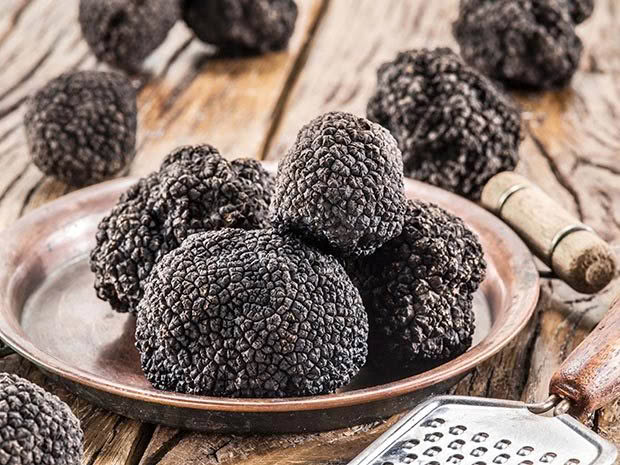
It’s an underground treasure whose production is unpredictable, but a gastronomic delight that chefs will pay $3500 per kilogram to thinly shave over a dish.
Words: Sheryn Dean
Truffles are not just chocolate balls rolled in coconut. The ones that stir up a lot more excitement thanks to their amazing price per kilogram are an edible mushroom that grows on the roots of trees.
The correct term is ectomycorrhizal fungi and there are many different types throughout the world, growing on many different types of trees. Most of them are north of the equator and they are best eaten fresh. But it wasn’t long before someone decided it would be a good idea to learn how to grow them in New Zealand, and supply the northern hemisphere in its off-season.
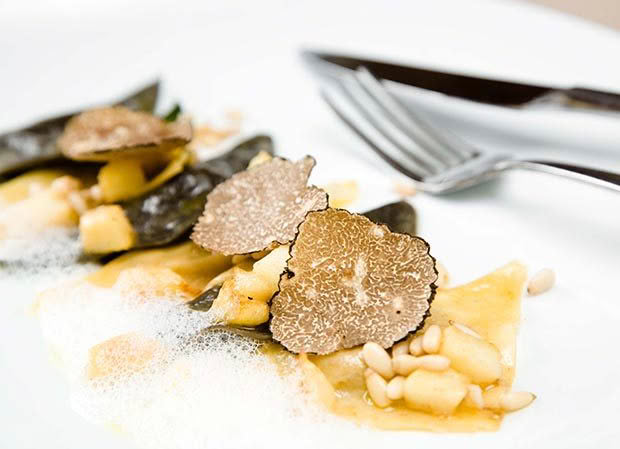
Of all the truffles, the Périgord is considered the elite. This black truffle originates from the Périgord region of France and looks like a lump of dirt. It is getting harder and harder to find these tasty lumps in Europe, in part due to deforestation, and scientists began investigating ways to cultivate them. By the 1980s, NZ scientists had their first trees ready for planting and New Zealand harvested their first few small truffles near Gisborne in 1993. A new industry was born.
But 24 years later the truffle industry in New Zealand is still precarious. Production is uncertain, stories of failure and financial loss are more common than pots of gold, and marketing is disjointed and ad hoc. Although I am assured most truffle farmers in NZ are serious growers doing it for the financial return, the reality is it is a long-term, high-risk investment. That is exactly what makes it fun, a big challenge and what makes growing trees so interesting.

Since the Périgord black truffle is grown on oak and hazel trees and oak and hazel trees would look very nice beside my drive, I figured they would be worth the $73.75 per tree investment and I could have a bit of fun along the edge of my entranceway. The first task was to adjust the pH of my soil, currently testing around 6.4. The ideal for truffles is 7.9 for truffles, and it required the application of lime. Lots of lime.
The pH scale is logarithmic. Times pH 6 by 10 to get pH 7 and by 100 (10 x 10) to get pH 8, so to adjust from 6.4 to 7.9 requires tonnes of lime applied at intervals and hoed in over a number of years.
Being the patient, scientific and precise person I am (not), I borrowed a mate’s digger and loaded my father-in-law’s truck with waste fine lime from the local mill. By the time we’d returned the digger keys and had a few beers it was dark so we decided to unload the truck the next morning. By morning we had a truckload of concrete. At full hoist, with a bit of jigging, small chunks of lime slid off at the speed of the Fox Glacier.
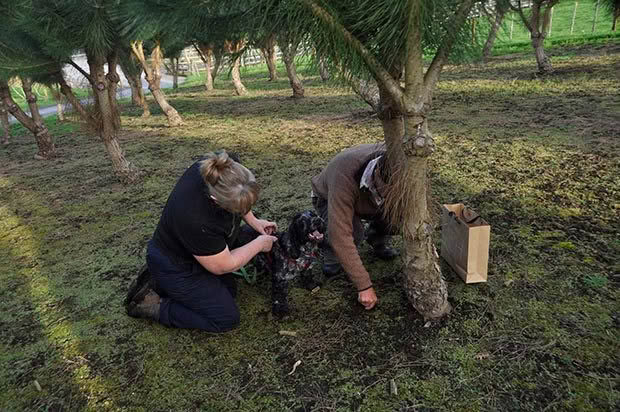
By the time we shovelled, pushed and pulled, we were very over lime. Instead of it being spread evenly over the soon-to-be truffière and hoed in, it was dumped in a pile with the rain left to wash it wherever. Then the trees finally turned up. While we were busy building our house. They got planted, fenced and left to grow.
In those days (2008) I could only source common oaks and seedling hazels inoculated with the Périgord or Burgundy truffle fungus but today you have the choice of Périgord or Bianchetto, the white Italian truffle on commercial hazelnut varieties, common oaks, holm oaks, Turkey oaks, pine nuts or radiata pine.
Several years later I idly wondered if the truffle spores could still be viable. Nobody could or would give me a straight answer. They may or may not. I called a consultant and sent soil samples away to a laboratory. My bank balance suffered considerably and in return I got a glossy folder telling me to spend more money.
I opted to buy a fireplace for the house instead and now I can’t find the folder. Maybe I used it as kindling. Time passed and the trees grew into trees alongside the drive. The oak held onto its leaves all winter, looking rather dead and bedraggled most of the time instead of giving us a show of autumn glory. The hazels shed piddley little nuts barely worth cracking. They gave some shade and shelter to the sheep but mostly languished, largely forgotten and happily growing like trees do.
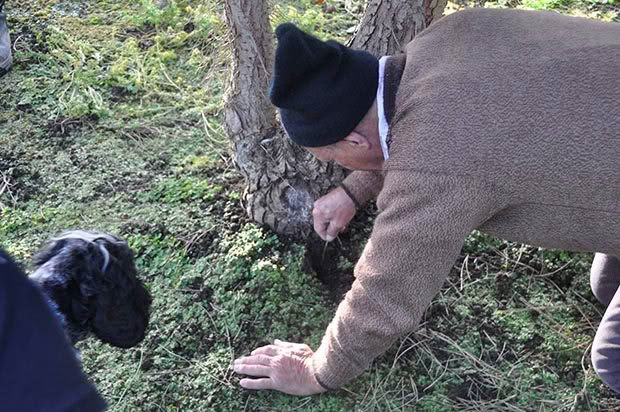
A few years later I was researching an article on truffles for the TreeCropper magazine and talked with staff at Plant and Food Research with French-sounding names. They said my truffière could quite possibly be producing. I explained about their lack of care (and money). They said other trees from my batch were producing on other plantations – mine could well be too. I explained how I didn’t hoe or spray the ground, just grazed the sheep under them. They explained that the mychorizzal fungi are pretty hardy. I explained about the dumping of lime.
They told me TO GO AND LOOK. I went and looked. When truffles are growing they out-compete and kill off grass, forming a bare brule (really terre brûlé or burned ground) around the roots of the tree. You can imagine my excitement to see there was a bare patch around the tree planted in the middle of what had been the lime dump. An interesting side note: seven years later, I could still visibly see the layer of lime in the soil when I dug a test hole. Plant and Food insinuated (politely) that my brûlé was pathetic. However, this is the Waikato. We do grow good grass here and the lack of it indicated something was afoot, or rather, underfoot.
The problem is the black truffle looks like a black lump of dirt, so finding them is also as much as an art as growing them. Luckily pigs, particularly sows, have a keen sense of smell and a fondness for truffles as (apparently) the truffle aroma is identical to a pheromone produced by boars pre-mating. Disconcertingly, I really fell in love with the smell of a fresh Périgord truffle the first time I smelt one, and I am not one to savour scent. It is a deep, strong smell, not overpowering, neither musky nor sweet but quite unlike anything I have smelt before (obviously never having been courted by a boar). It’s not mouth-watering or perfumey but somewhere between the scent of a good soil and a good aftershave.
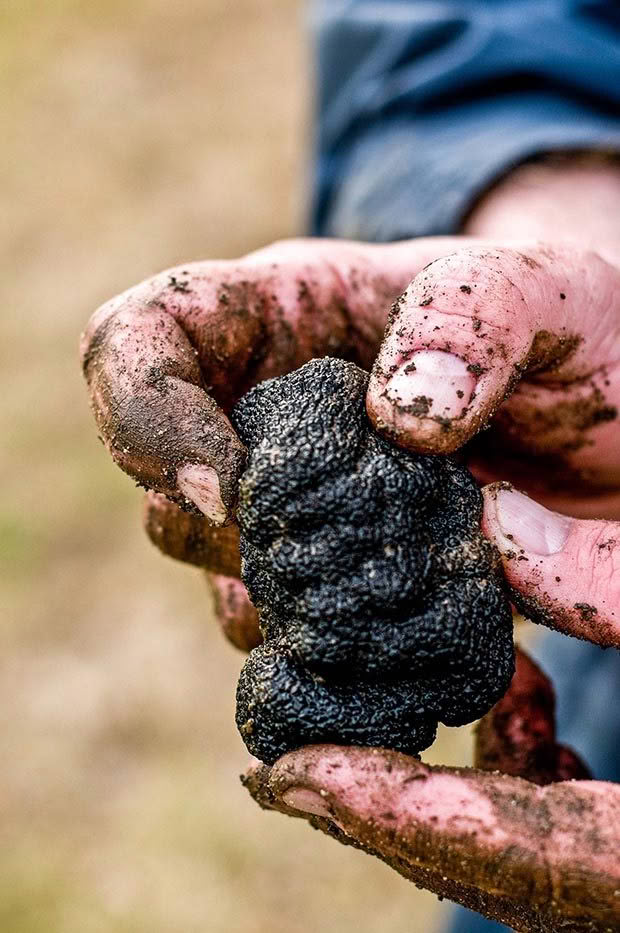
The pheromone, androstenol, which creates this aroma is also produced, to a lesser extent in humans, so I am not that weird. My pet Black Devon sow Sally happily followed me anywhere so we went for a walk down the drive one Sunday. She went straight to the bare patch, grunted around energetically for a few seconds, then proceeded to happily graze for the next half hour while I watched her anxiously. I couldn’t see anything where she grunted and ruffled but one lump of dirt looks a lot like a truffle and there was no way I was putting my hand between a 200kg sow and a swine aphrodisiac so I will never know for sure. But all points were positive. I looked at my small collection of oaks and hazels anew and began to call it a truffière.
While talking to other growers, I randomly heard that slugs eat truffles. A little alarm went off in my head: we have a serious slug problem here. When I was looking to buy the property, I had to take off my jandals to walk across the grass because there were so many squashed slugs and slug slime in between shoe and foot, it was impossible to walk. I have had ducks free ranging for 10 years and have gone through hundreds of dollars worth of organic slug bait. By trial and error, I am rather an expert at collecting, trapping and stopping slugs (I will write about this one day).
But if slugs were eating my truffles, the war just went up a degree or two. I began keeping the grass shorter, grazing harder and mowing more often, and I spread bait under the trees. I got more ducks.
The bare, possible brûlés got bigger. Another tree developed a bare ring around it. Disconcertingly, a definite sheep track linked the two. I queried Plant and Food if sheep could track the mycorrhizae from one area to another. The response was a photo of a real brûlé, much larger and obvious than my little bare patch. I refrained from pointing out that my grass is rather good – lush and strong – and anything competing with it has to be lusher and stronger and privately considered it all points were still positive. I organised a foodie weekend and booked a dog.
Unlike pet pigs, a trained dog will mark the truffle and allow you to dig it up. Karen and Indi the cocker spaniel from Truffle Dog Services obligingly arrived while we were harvesting and cooking and eating all manner of yummy foods. The fresh pasta was resting and we were all set to turn my first fresh truffle into the ultimate of gourmet delights. We rugged up in warm jackets, locked our dog away and traipsed down to the truffière.
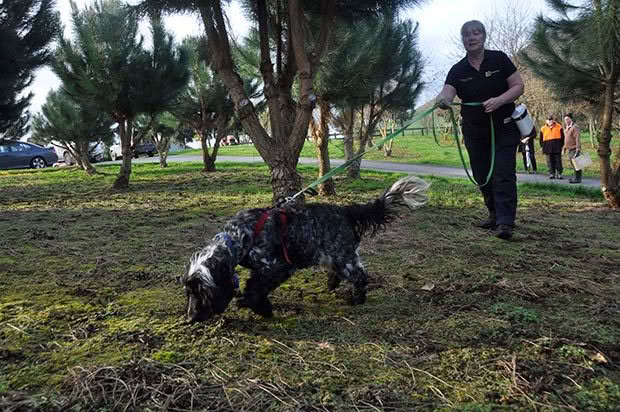
It is important for a truffle dog’s health that the ground is free of prickles, prunings and nasty things that can get in her feet or snout. Luckily frequent mowing in the rain had finally killed my rather abundant crop of Californian thistles and the understorey looked like a lawn. Indi put her nose to the ground. She was on a leash, directed by Karen, and systematically searched around each tree.
She ran straight over my maybe brûlé without stopping. She didn’t even pause for a second. We huddled in the cold for a while watching her then returned to the warmth of the kitchen to make pasta with fresh herbs.
Karen was extremely nice about it all and arranged for me to join her at another hunt at a real, producing, truffière. John Triegh’s plantation is a total contrast to mine. His trees are in straight rows, tidily pruned and the ground sprayed bare underneath. He really did spend several years applying and hoeing in tonnes of lime.
And he had truffles. Indi indicated, John poked with a wire and for the first time in my life I saw a freshly-harvest, genuine Pergiord truffle. Like myself, John had never tasted a truffle before deciding to grow them. Truffles are best eaten fresh and almost impossible to buy in NZ unless you know a grower. Much of the available truffle oil is artificially made. The truffle-infused camembert I have purchased in NZ is made with imported truffle powder. So the key question was, are truffles really worth all the hype?
John said the NZ Truffle Association cemented his interest, and they have “dinners to die for” at their AGM, along with a matching wine list. He also said a ripe truffle keeps only for a very short time frame, about 10 days. Which means that if and when you find one, getting it to a top-end restaurant and hawking it, and the chef putting it on the menu and the customer buying it, all has to happen rather quickly.
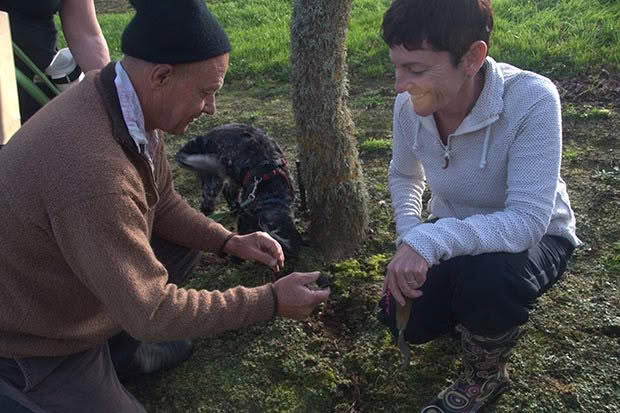
There are a couple of distributors buying, but the uncertain supply and limited shelf life makes getting them to market tricky. You can use them in salt, butter, even ice-cream apparently. Anything that will take their flavour. John believes there is potential in creating a hard truffle cheese and would like to hear from anyone interested in experimenting with this. Meanwhile, I might sprinkle a little bit more lime.
3 INTERESTING THINGS ABOUT TRUFFLES
1. No-one really knows, but Karen estimates there are about 250-350 truffieres, of varying sizes, within New Zealand. The NZ Truffle Association reports about 30 are producing truffles.
2. The biggest threat to a successful truffiere is competing and overpowering fungi, especially the edible but commercially inferior Tuber brumale or winter truffle.
3. Chocolate truffles are named ‘truffles’ because of their resemblance to the real thing. These chunks of chocolate mimic the shape and size of a truffle, in addition to having dusted coco powder on them to symbolize the dirt.
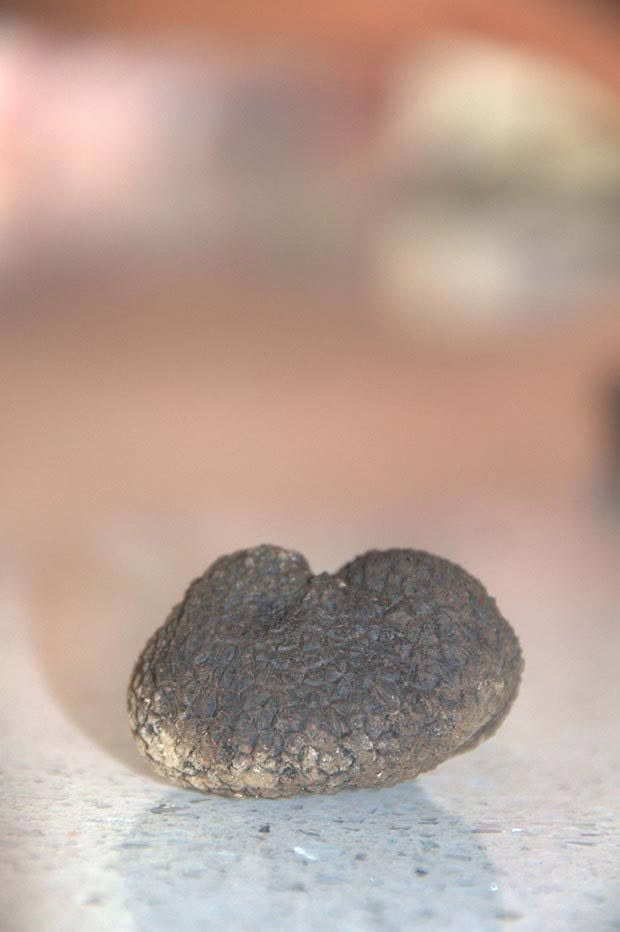
RESOURCES
NZ Truffle Association
This website also lists consultants, suppliers, dog handlers and some growers.
www.nztruffles.org.nz
Truffle trees
Innoculated truffle trees can be purchased from several sources including Southern Woods Nursery and Kings Truffles. It pays to order well in advance.
www.southernwoods.co.nz
www.kingstruffles.com
Book
Taming the Truffle – The History, Lore, and Science of the Ultimate Mushroom by Dr Ian Hall – a pioneer of the NZ truffle industry and now consultant – and others.
www.trufflesandmushrooms.co.nz
Truffle Dog Services
Karen and Indigo will search truffieres from the Central Plateau north.
truffledogservices.co.nz
Where to taste truffles during the season (winter – spring)
A few top-end restaurants are offering truffles when available. The Grill at Sky City, Auckland has a dedicated truffle menu and Black Estate, Waipara, North Canterbury has some truffle dishes on their menu. Occasionally Limestone Hills will sell fresh truffles at the Waipara Valley Farmer’s Market on a Saturday morning.
Foodie Weekend
A mid-winter retreat on Sheryn’s block at Tirau, harvesting, cooking, eating and talking fine food. Who knows, maybe next year she will have a truffle. www.Lals.nz
Love this story? Subscribe now!
 This article first appeared in NZ Lifestyle Block Magazine.
This article first appeared in NZ Lifestyle Block Magazine.
